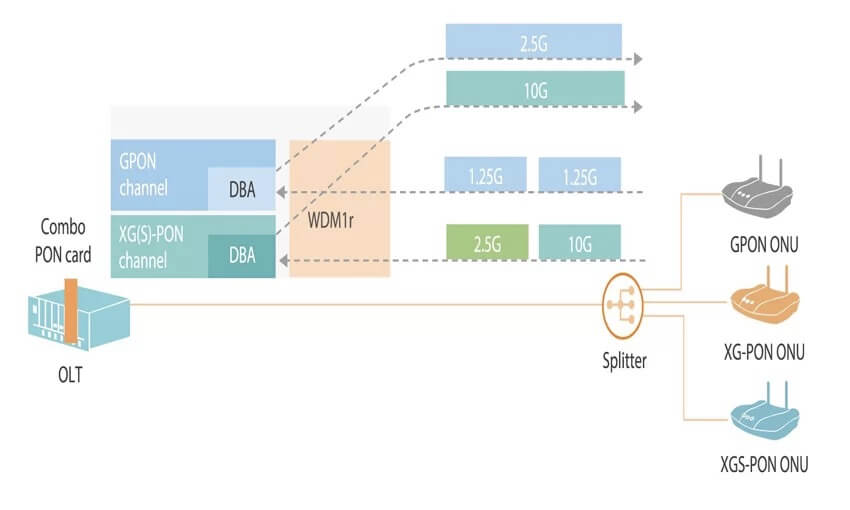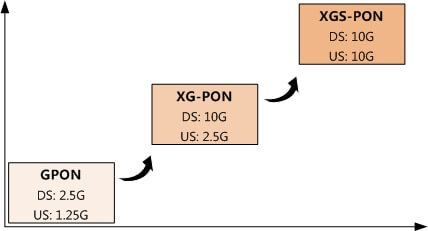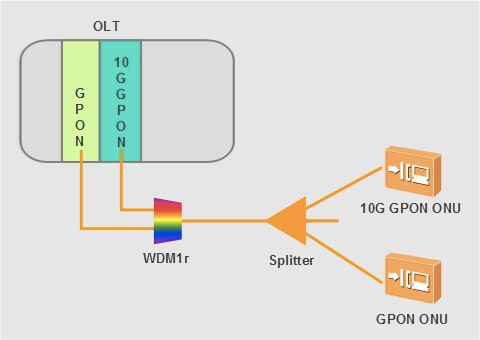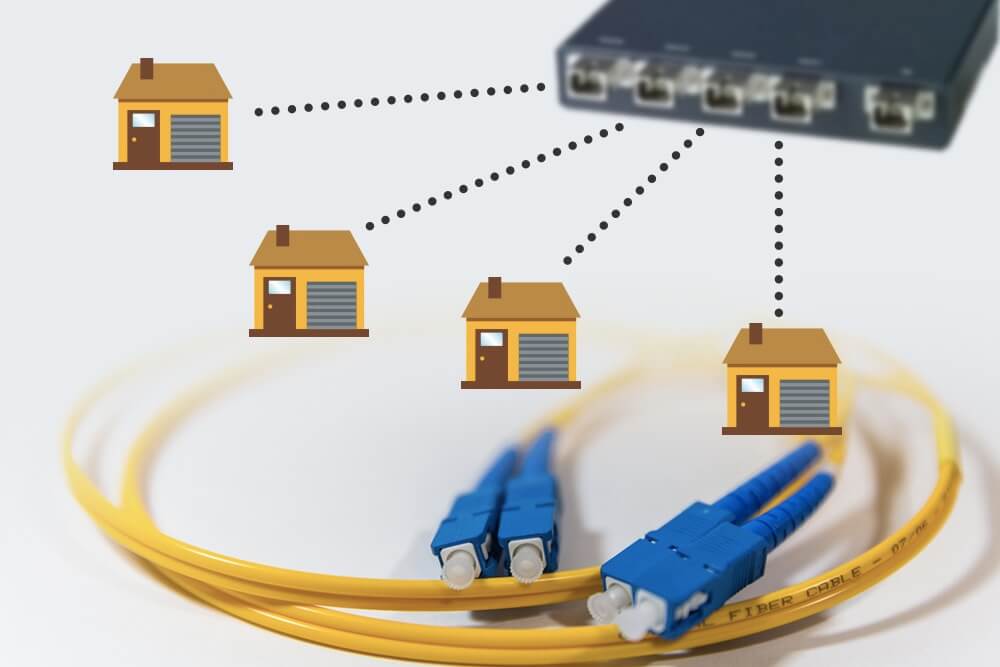Passive Optical Network (PON) technology has become one of the mainstream technologies for Fiber-to-the-X (FTTx) network construction. With the continuous growth in user demand for high bandwidth, especially with the popularity of high-traffic applications such as OTT videos and 4K TV, operators are incorporating 10G GPON technology into their plans to meet the urgent need for faster and more reliable network connections.
GPON is generally divided into three commonly used types: GPON, XG-PON, and XGS-PON. In fact, is it really classified this way?
Bonelinks will take you into the world of GPON, XG-PON, and XGS-PON. Let’s dive right in!
1. GPON
1.1 Overview of GPON
Gigabit Passive Optical Network (GPON), as a fiber optic transmission technology, achieves high-speed, high-bandwidth network connections by utilizing a single optical fiber line to transmit data. The fundamental principles of GPON involve optical transmission and the use of splitters. In a GPON network, a single optical fiber line connects multiple users, distributing signals to different terminal users through splitters, thereby facilitating data transmission.
The architecture of GPON includes the Optical Line Terminal (OLT) and the Optical Network Unit (ONU). The OLT is responsible for communicating with the user-side ONU, while the ONU communicates with user devices. This distributed structure enables the GPON system to support a large number of users, making it widely applicable in various fields.
1.2 GPON Technical Specifications
One of the most prominent features in the technical specifications of GPON is its high bandwidth requirements. GPON typically provides transmission rates of 1.25 Gbps (downstream) and 2.5 Gbps (upstream). This high bandwidth allows GPON to excel in supporting high-definition videos, large-capacity file transfers, and other high-traffic applications.
Additionally, GPON has a certain advantage in terms of distance. Optical fiber transmission allows signal transmission distances of up to several tens of kilometers, meeting diverse network topology requirements.
Due to the relatively lower upstream speed of GPON, the cost of components in the ONU’s transmission assembly (such as lasers) is also lower, resulting in a lower overall equipment cost.
1.3 Characteristics of GPON
- High Bandwidth: GPON can provide transmission rates of up to 2.5 Gbps (upstream) and 1.25 Gbps (downstream), meeting users’ demands for high-speed broadband connections.
- Point-to-Multipoint Architecture: GPON adopts a point-to-multipoint fiber optic transmission architecture, connecting the Optical Line Terminal (OLT) and multiple Optical Network Units (ONUs) through a single optical fiber line. This distributed architecture allows multiple users to share the same optical fiber, improving network resource utilization.
- Symmetric and Asymmetric Transmission: GPON supports both symmetric and asymmetric transmission, meaning upstream and downstream transmission rates can differ. This flexibility enables the network to better adapt to the requirements of different users and applications.
- ITU-T Standards: The technical specifications of GPON are defined by the International Telecommunication Union Telecommunication Standardization Sector (ITU-T) and are detailed in the G.984.x series recommendations. This provides a unified standard for devices from different manufacturers, enhancing device interoperability.
1.4 Advantages and Limitations of GPON
One of the advantages of GPON is its relatively low cost. Compared to traditional copper cable networks, fiber optic networks are generally more cost-effective, especially in large-scale deployments. Additionally, GPON’s support for symmetric and asymmetric transmission makes it suitable for various application scenarios.
However, GPON also has its limitations. Due to limitations in transmission rates and bandwidth, the network may face bandwidth bottlenecks as user demands increase. Upgrading GPON systems to meet higher requirements may pose technical and economic challenges.
1.5 Applications of GPON
GPON is widely used in various fields, including:
- Home Broadband Networks: GPON provides high-speed, stable broadband connections for home users, supporting needs such as high-definition video streaming and online gaming.
- Enterprise Networks: In corporate environments, GPON can offer reliable communication infrastructure to meet the demands of daily office activities and large-scale data transfers.
- Government and Educational Networks: GPON is extensively used in government agencies and school networks, satisfying the requirements for high bandwidth and network stability in these institutions.

2. 10G GPON
2.1 Key Drivers for 10G GPON Adoption
- Business Development Needs: With the advent of the digital era, there is a continuous increase in user demand for high bandwidth and high data rates. The widespread use of high-traffic services such as video streaming, high-definition content, and virtual reality is driving a rapid growth in network bandwidth. Traditional GPON technology may face bottlenecks in meeting the high bandwidth requirements of these services, leading to the emergence of 10G GPON to fulfill the need for higher data transmission rates.
- Innovation in User-Side Access Technology: As emerging technologies such as 5G, the Internet of Things (IoT), and cloud services develop, user demands for higher bandwidth and lower latency are also on the rise. The introduction of 10G GPON enables networks to better adapt to the development of these innovative technologies, providing a more advanced user experience.
- Greater Splitting Ratios and Longer Transmission Distances: 10G GPON technology offers larger splitting ratios, meaning more users can share the same optical fiber, thereby improving network resource utilization. Additionally, it supports longer transmission distances, allowing the network to cover broader areas and providing greater flexibility for long-distance transmission.
2.2 Standards for 10G GPON
10G GPON has two main standards, namely XG-PON and XGS-PON:
- XG-PON: Asymmetric 10G GPON, providing asymmetric transmission rates with a maximum downstream line rate of 9.953 Gbit/s and a maximum upstream line rate of 2.488 Gbit/s. XG-PON meets the downstream high-speed rate requirements while having a relatively lower upstream rate, suitable for most home broadband and business application scenarios.
- XGS-PON: Symmetric 10G GPON, offering symmetric transmission rates with both maximum downstream and upstream line rates at 9.953 Gbit/s. XGS-PON, through symmetric transmission, better meets the requirements of scenarios demanding high rates in both upstream and downstream directions, such as symmetric broadband services and enterprise applications.
Bonelinks will now provide a detailed introduction to these two standards of 10G GPON.
3. XG-PON
3.1 Introduction to XG-PON
XG-PON, or 10-Gigabit Passive Optical Network, is an upgraded version of GPON designed to provide higher transmission rates and longer transmission distances. Compared to GPON, XG-PON significantly increases the downstream and upstream transmission rates to 10 Gbps and 2.5 Gbps, respectively, offering users greater bandwidth support.
The technical evolution of XG-PON is primarily reflected in its improvements to optical modulation methods and innovations in multi-wavelength technology. These enhancements enable XG-PON to better meet the demands of high-bandwidth applications and future network requirements.
3.2 XG-PON Technical Specifications
In comparison to GPON, XG-PON exhibits a significant enhancement in bandwidth and transmission rates. This makes XG-PON more suitable for applications that demand higher bandwidth, such as 4K/8K video streaming, virtual reality (VR), and augmented reality (AR).
XG-PON also demonstrates relatively good distance performance, covering broader areas and providing greater flexibility for long-distance transmission.
3.3 XG-PON Compatibility and Upgrades
XG-PON exhibits a certain level of compatibility with GPON, allowing operators to gradually upgrade to XG-PON while retaining existing GPON infrastructure, eliminating the need for a complete equipment replacement. This smooth upgrade path assists operators in adapting to market demands while maximizing the protection of their investments.
Upgrading to XG-PON also offers users a better service experience, especially in situations that require higher bandwidth. This upgrade is particularly crucial for supporting large-scale, high-density user environments.
3.4 Future Trends in XG-PON Development
The future development trends of XG-PON in the field of optical fiber communication primarily include the demand for higher rates and adaptability to more business scenarios. As the digital era continues to evolve, the demand for network bandwidth and performance will steadily increase, and XG-PON, as a high-bandwidth solution, will continue to play a crucial role.
In the future, XG-PON may integrate with other technologies, such as 5G, for a more comprehensive and flexible solution to meet the growing demands of a digitized society.
4. XGS-PON
4.1 Overview of XGS-PON
XGS-PON, short for 10-Gigabit Symmetric Passive Optical Network, is a further technological innovation built upon XG-PON. In comparison to XG-PON, XGS-PON provides symmetric 10 Gbps transmission rates in both downstream and upstream directions, excelling in scenarios that require high levels of symmetric data transmission.
The technological innovation of XGS-PON primarily focuses on its higher symmetric transmission rates and the more flexible application of multi-wavelength technology.
4.2 Technological Innovations in XGS-PON
A notable technological innovation of XGS-PON is the enhancement of symmetric transmission rates. By offering symmetric 10 Gbps transmission rates, XGS-PON better supports applications with high demands for symmetric bandwidth, such as high-quality video conferencing and cloud computing.
The application of multi-wavelength technology is another significant innovation of XGS-PON. This technology allows the simultaneous use of multiple wavelengths, enabling wavelength division multiplexing on the optical fiber, thereby increasing network capacity and flexibility.
4.3 Support for Multiple Services in XGS-PON
The symmetric transmission rates and the application of multi-wavelength technology in XGS-PON make it more flexible in supporting various business scenarios. In addition to traditional home broadband and enterprise network applications, XGS-PON can better meet the demands of emerging application areas, such as the Internet of Things (IoT) and communication needs in the 5G era.
4.4 Security and Reliability of XGS-PON
XGS-PON inherits the advantages of previous technologies in terms of data transmission security and network reliability. Optical fiber transmission itself provides a high level of security, and XGS-PON, while offering higher bandwidth, maintains high requirements for data security and network reliability.
The deployment of XGS-PON not only provides users with more efficient and flexible services but also exhibits long-term sustainability in meeting the demands of the future digitized society.
5. GPON vs XG-PON vs XGS-PON Comparison

| Characteristic | GPON | XG-PON | XGS-PON |
| Downlink Rate | 2.5 Gbps | 10 Gbps | 10 Gbps |
| Uplink Rate | 1.25 Gbps | 2.5 Gbps | 10 Gbps |
| Symmetric Rate | No | No | Yes |
| ITU-T Standards | G.984.x | G.987.x (XG-PON) | G.9807.x (XGS-PON) |
| Wavelength | 1490 nm(Downlink) | 1577 nm(Downlink) | 1577 nm(Downlink) |
| Wavelength Division Multiplexing(WDM) | No | No | Yes |
| Multi-wavelength Technology | No | No | Yes |
| Application | Home Broadband, Enterprise Network | Scenarios with Higher Bandwidth Requirements | Multi-wavelength, High-density User Environment |
| Typical Manufacturer Equipment | Huawei, ZTE, etc. | Huawei, Cisco, etc. | Huawei, Nokia, etc. |
| Main Advantages | Mature and Widely Used | Provide Higher Speed | Symmetric Transmission, Multi-wavelength Technology |
| Main Challenges | Limited Bandwidth | Deployment is relatively complex | Deployment is relatively complex |
6. Coexistence and Compatibility of GPON, XG-PON, and XGS-PON
6.1 Coexistence
GPON, XG-PON, and XGS-PON can coexist on the same optical fiber by using different wavelengths. GPON uses 1310nm for upstream and 1490nm for downstream, while XG-PON and XGS-PON use 1270nm for upstream and 1577nm for downstream. This allows GPON and XG-PON/XGS-PON to operate simultaneously on the same optical fiber without interference.

6.2 Compatibility
GPON, XG-PON, and XGS-PON are all based on ITU-T G.984.x and G.987.x standards, ensuring good interoperability. This means that if a user’s equipment (such as ONU) supports GPON, it can also work in an XG-PON or XGS-PON network. This compatibility is advantageous for operators as they can gradually upgrade their networks without replacing user equipment.
7. Summary
GPON (Gigabit Passive Optical Network) is an access technology based on the ITU-T G.984.x standard for Passive Optical Networks (PON). It is considered an ideal solution for FTTx, especially FTTH, due to its characteristics such as high bandwidth, good interoperability, manageability, and efficiency. However, with the proliferation of PON and the demand for comprehensive services, there is an expectation to enhance performance in terms of bandwidth, service support capabilities, and access network equipment while safeguarding existing investments. Therefore, GPON is evolving towards the next generation, namely 10G GPON, including XG-PON and XGS-PON.
The upstream bandwidth of GPON is 1.25G, and the downstream bandwidth is 2.5G. Due to the relatively lower upstream rate of GPON, the cost of components in the ONU (such as lasers) is also lower, contributing to a lower overall device cost.
XG-PON (10-Gigabit-capable Passive Optical Network) is a higher bandwidth version of GPON. It shares the same functionalities as GPON and can coexist on the same optical fiber. The upstream bandwidth of XG-PON is 2.5G, and the downstream bandwidth is 10G.
XGS-PON (10-Gigabit Symmetric Passive Optical Network) is an evolution of GPON and XG-PON, supporting the access of GPON ONU, XG-PON ONU, and XGS-PON ONU. Both upstream and downstream rates of XGS-PON are 10G. With the rise of services such as live streaming and video surveillance, which demand higher upstream bandwidth performance and symmetric upstream/downstream circuits, XGS-PON is proposed.




